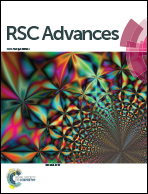Tunable luminescence properties of the novel Tm3+- and Dy3+-codoped LiLa(MoO4)x(WO4)2−x phosphors for white light-emitting diodes†
Abstract
A series of Tm3+- and Dy3+-codoped LiLa(MoO4)x(WO4)2−x phosphors were prepared via the conventional solid-state reaction method. It was discovered that the optimum single doped concentrations of both Tm3+ and Dy3+ are 0.04 for the LiLa(WO4)2 host; moreover, LiLa(WO4)2:0.04Tm3+ and LiLa(WO4)2:0.04Dy3+ emit blue and yellow light, respectively. On the other hand, the emission colors of Tm3+- and Dy3+-codoped LiLa(WO4)2 could be tuned from blue to white by tuning the energy transfer. With increase in the Dy3+ doped concentration, the energy transfer efficiency of LiLa(WO4)2:0.005Tm3+,yDy3+ increased gradually and reached as high as 88% when the concentration of Dy3+ was 0.05. The energy transfer from Tm3+ to Dy3+ was revealed to be resonant via the quadrupole–quadrupole mechanism. As for LiLa(MoO4)x(WO4)2−x:0.005Tm3+,0.03Dy3+ phosphors, the emission intensities of both Tm3+ and Dy3+ were found to reach a maximum when the molar ratio of Mo/W was 0 : 2. In addition, with increase in the proportion of MoO42−, the location of the chromaticity coordinates changed from the edge to the center of the white area. When the relative ratio of Mo/W was 2 : 0, the chromaticity coordinates were much closer to the standard chromaticity coordinates for white light. The results indicate that these phosphors may have potential applications in the fields of UV-excited white light-emitting diodes.


 Please wait while we load your content...
Please wait while we load your content...